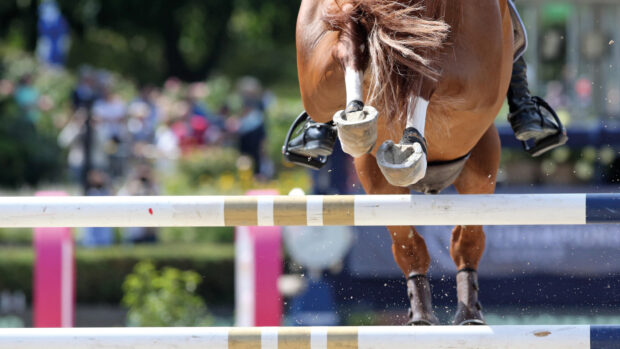Weeding out “soft qualifications” is vital for the future of elite-level eventing and ensuring that only the right competitors get to five-star.
That was the overarching message from the FEI eventing risk management forum in Jardy (20-23 January) as the sport’s leaders scrutinised the standards at CCI5*. They looked at who is getting there and how, and debated whether qualification needs to be harder to achieve.
The key point to emerge was that courses and standards at levels below five-star have to be consistent and up to scratch, with consequences for events whose courses are found lacking.
Badminton Horse Trials director Jane Tuckwell said she is worried about how riders can “manipulate” minimum eligibility requirements (MERs).
“I don’t necessarily think there should be more MERs or it should be harder. But it’s the length of time perhaps over which you can do that,” she said.
Bruce Haskell this “isn’t a five-star problem” and “if the level below that is inadequate, we need to make that better”.
“It seems like a global challenge for us to make sure our officials and our course-designers are pushing the standard so four-star means four-star,” he said, stressing that eventing “cannot be a Eurocentric sport”.
There is already a rule stating that national federations take responsibility for riders’ “fitness and competence to compete” at international events, and the forum was asked whether that should be taken further.
British Eventing (BE) chief executive Helen West said BE is looking at whether it should be stopping riders who are flagged red on its risk management system from entering events, and contacting them to say they need to drop down a level before moving back up again.
“We were also discussing going one step further and potentially, if they are flagging amber, sending an email to make them aware and suggest they continue to get more form before stepping up,” she said.
The forum broke into smaller discussion groups to focus on specific issues. Course-designer Mike Etherington-Smith reported back from the five-star group.
He said the group agreed that five-stars are still the pinnacle of the sport and need to remain as such, retaining the technical requirements, and that the variety in global five-star events is good as they suit different horses.
“One of the things that everybody felt is that the pathway to these competitions is absolutely key,” said Mike.
“Somehow there has to be a way of filtering out what I call the tourists, people going there just because they think they’re good enough and they want to have a crack. If you’re good enough, then great. But if you’re not, don’t go near it.”
He added that a “major piece of education has to be done”, not only with the athletes but also with coaches, officials, national federations and the media, that just because someone is qualified does not mean they are ready.
“We have a really good bunch of five-star organisers, who are absolutely alert to all the issues and we can feel very confident in the way they’re thinking and the way they’re looking ahead,” he said.
FEI eventing committee member and course-designer Alec Lochore reported that his working group flagged concerns over “considerable variation” in standard of courses globally and how this might be addressed.
“A two-star in western Europe has to be the same as a two-star in Japan, or New Zealand, or Argentina,” he said.
One of the ideas was to analyse fixtures’ statistics, which would show if an event – or even a designer – has an abnormally high cross-country clear rate and may suggest those courses are “too soft”.
“A one-off can be tackled more easily, but if there’s a trend with a course-designer or with a venue… then the FEI should be involved,” he said. “They should issue a supported warning with a plan for the improvement of the standard, to work with the course-designer, and failing that, they might even have to appoint somebody to go in there to assess the situation.”
FEI risk management steering group member Laurent Bousquet said consequences could include forcing an event to drop down a level, if it does not improve sufficiently.
He added that courses should also be the same standard throughout the year.
“There were some comments saying, ‘Well [a course] could be a bit softer in March than in October’. No. If your horse is not ready to run a four-short in March, you have to run at three-star. That’s it,” he said, reiterating the effect variations in standard may have on who collects MERs.
Officials were also urged to raise any concerns they have before an event, which could be rectified before the competition starts, and asked to be “absolutely accurate and honest” on feedback forms after a fixture.
There was also debate over whether the number of longer black-flagged routes across country a competitor can take and still get an MER should be limited to two. One related suggestion was to reduce the cross-country time penalties allowed for an MER.
On one side, it was argued that competitors who take every available long route are not answering the cross-country question. On the other, could it push riders to make poor choices?
“All of the conversations that we have at these meetings are about trying to have better horsemanship from our riders. That’s really what it comes down to,” said rider Jonathan Holling, who is also a national safety officer and part of the risk management steering group.
“And to me, I just personally feel like this really would discourage good horsemanship.
“I understand [competitors] have to answer the questions. So then I would say course-designers need to design courses that when you go the long route, you’re still educating those horses and riders.
“I just think we have to be careful that we don’t legislate the [good] horsemanship out of it.”
- What do you think? Send your thoughts to hhletters@futurenet.com, including your name, nearest town and country, for possible inclusion in the Horse & Hound letters pages.
You might also be interested in:

Subscribe to Horse & Hound magazine today – and enjoy unlimited website access all year round

Holding riders responsible for horse falls and removing fences – ideas to make eventing safer

Eventing risk profiles could help reduce cross-country falls

FEI responds to frangible-device debate surrounding Pau cross-country
Horse & Hound magazine, out every Thursday, is packed with all the latest news and reports, as well as interviews, specials, nostalgia, vet and training advice. Find how you can enjoy the magazine delivered to your door every week, plus options to upgrade your subscription to access our online service that brings you breaking news and reports as well as other benefits.




